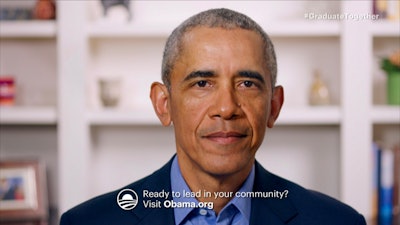
Chances are good that, in the last few months, you've attended a virtual event where a poorly lit speaker quickly lost your interest. As event attendees around the world continue to work from home, their days are filled with distractions, from email to social media to kids and pets. Speakers need to work overtime to deliver compelling content and adapt to this new normal.
To learn some new best practices, BizBash consulted a mix of professional public speakers, event planners, and marketing consultants. Read on for their biggest tips and tricks for virtual event speakers.
1. Consider your lighting and camera placement.
This is crucial for any sort of virtual presentation, whether live or prerecorded. “An eye-level camera setting is helpful for virtual eye contact with your audience," notes Jennifer Moxley, founder of Charlotte, N.C.-based communications agency Sunshine Media Network. "You're the visual they need to process, and the easier it is for viewers to consume your image, the less their brains have to dissect that information—and the faster the ears can get to work." If needed, add some books under your computer to reach the appropriate height; Moxley cites this post from political strategist Steve Schmidt as a great example of at-home ingenuity.
Proper lighting, adds Moxley, is also key. “Light your face, and darken the space behind you,” she says, by using any light source—lamps, desk lights, cell phone lights, or the increasingly popular ring lights. “Computer camera irises aren't as smart as we would like, so we have to help them as much as possible and ensure our faces are appropriately lit.”
And think through what shows up behind you on camera, advises Carla Stone, president of World Trade Center Delaware and a frequent event host and speaker. “Minimize background distractions. While you do not need to have a company banner as a background, screens filled with dirty dishes, laundry, or piles of toys are unprofessional,” she says. “And please, make sure that the kittens, puppies, and kids are in another room.”
Related: 5 Tips for Producing Professional-Looking Video Content at Home
2. Think through your appearance.
“While we do not expect [virtual] presenters to be in three-piece suits or high heels and pearls, they should be dressed in at least business-casual attire,” adds Stone. “No ratty university T-shirts or pajamas. After all, this is still a business meeting.”
Stone suggests doing a test recording to check your appearance before any sort of virtual presentation, then adjusting as needed. Remember that you show up differently on a computer screen than you would in person. “This may mean wearing more or less makeup or brighter colors because the lighting will be entirely different than in a conference room or on stage,” she notes.
And wear solid colors, adds Paige Arnof-Fenn, founder and CEO of global branding and marketing firm Mavens & Moguls. “A busy pattern can be distracting on screen.”
3. Test your tech.
Whatever you do, “Don’t wait until the last minute to log into the presentation platform, in case you need to download software,” advises Arnof-Fenn. “And make sure you have a phone number or back-up plan in case it does not connect online as planned.”
Rachel Cooper, event coordinator at AI-based production platform Newsbridge, located in France, agrees. “No matter how confident both parties are with video conferencing, always do a test run before the actual presentation or event,” she suggests. “Whether it's an audio glitch, lighting or placement issue, or even just rehashing the topic or questions at hand, it's always better to be prepared and address these bugs before going live.”
4. Pay attention to your body language.
A big pitfall of virtual events is the lack of eye contact—which can impair a speaker's ability to connect with the audience. Kristin Bock, the owner of Wisconsin-based Body Language Blueprints, suggests taping a Post-It note or a photo of a loved one above your computer camera to draw your eyes upwards. “Or in a pinch, simply drag your own video thumbnail to the top center of the screen,” she suggests.
Bock also suggests raising your chair’s armrests to keep your hands visible on camera. “Our hands are actually the first part of the body the brain pays attention to, and they work as trust indicators,” she says. “Our brain gives more weight to nonverbal communication, so keep hand gestures raised above the table and visible to build charisma and augment a message by essentially highlighting and underlining key points.”
5. Slow down!
“The pacing of voice reception is different than in person," notes Stone. "Expect and allow for pauses between sentences. It may take a while for the audio to be transmitted, or the audio starts before the image is transmitted. Synchronization may not be perfect.”
Arnof-Fenn agrees. “Smile when you speak, and slow down so they can hear you clearly,” she says. “Be as natural and relaxed and warm as possible, and be animated and energetic.”
6. Interact with the audience whenever you can.
“In a virtual environment, the attention rate of the audience will be much lower because they could have distractions such as looking at their email, their kids running around in the background, and [other] multi-tasking,” notes Sandy Yong, a Toronto-based author, event coordinator, and frequent guest speaker who suggests adding polling, visual aids, and breakout sessions to your presentations.
Meanwhile, Stone suggests encouraging questions from the start of the event. “Be sure that participants can type in questions throughout the presentations. Have someone monitor the questions and rephrase, combine, or eliminate questions as needed,” she says.
When in doubt, says Moxley, think of your presentation as a news broadcast. “Being virtual isn't a new concept—news anchors and reporters have [always] had virtual presentations. What is new is presenters and event planners unfamiliar with the format,” she points out. “Model your information after a newscast. Animations, graphics, natural sounds, talking heads in short snippets, multiple opinions, faster-paced, and condensed. It's not necessary to shorten a 20-minute presentation to two minutes—but the more succinct your presentation, the more it incorporates slides, video examples, and digestible pieces of your monologue, the more well-received it will be by your audience.”
But, cautions Stone, make sure any visuals are strategic and useful considering the environment. “We have all lived through ‘death by PowerPoint,’ or someone reading a technical paper word for word instead of making a presentation. As awful as this is in a conference, it is even worse in a virtual event,” Stone says. “Keep the slides few, interesting, and easy to read on a very small screen.”
Related: 10 Smart Tips for Keeping Attendees Engaged Before, During, and After a Virtual Event
7. Don’t do the exact same presentation you would have in-person.
“Virtual speakers need to modify their presentations for the medium; they can't simply do the talk they were going to do, just into a camera,” says John Arthur, author of the new book Improve Your Virtual Meetings. One crucial note: go shorter. “If you were going to have someone talk for an hour, consider doing just 30 or 45 minutes if virtual. When you are not in the room with the energy of a crowd or the ability to shift your attention by looking around the room, each minute can seem longer,” Arthur says.
Related: Ask BizBash: How Long Should a Virtual Event Last?
8. More than ever, it’s all about content—and connection.
“Now that many events are being moved online, speakers who once imagined themselves awing a live crowd on the big stage are having a hard time making an impact on an audience that is miles and many screens away,” notes Lee M. Pierce, Ph.D., an assistant professor of Rhetorical Communication at SUNY Geneseo who has also given two TEDx talks. “Whether it's pitching, composing, or performing, every speech should be treated as if it needs to work in person and online equally well. Suddenly, crutches like a microphone to amplify your voice, or a giant screen to project glitzy visual aids, don't seem so appealing. Also, gimmicky habits like crouching on stage or running into the crowd disappear.”
That means, of course, that content is more crucial than ever. Pierce has a few suggestions for effective speeches, regardless of context: “Ditch the cliches. … If you can't repackage an idea to give it new life, keep looking,” she advises. “[And] use analogies. Analogies are extended comparisons of two things to bring your audience new understanding. ... Analogies require complex development and attention to writing. As a result, your audience gets to participate in your thought process and get that ‘aha’ moment that they paid good money to receive. Learn to construct good analogies, and use them often.”
Finally, Pierce says, “Tell a real narrative. In real life, nobody suddenly hits their rock bottom and then transforms their life. Stop using phrases like ‘suddenly, everything changed’ or ‘at that moment I knew.’ Instead learn to tell a real story, with plot structure, rising action, and a clear, single-lesson takeaway. … Show them that work rather than repeating false promises that if life just gets bad enough, suddenly that work gets easier.”
Related: Podcast: Essential Rules for Event Speakers
And don’t forget, adds Alain Hunkins, a Netherlands-based professional speaker and the author of Cracking the Leadership Code, “With virtual, it's all about intimacy. Everyone in the audience has a front-row seat and is only six inches away from the speaker's face. Being able to connect at an intimate level is a key ingredient to success."
Also, empathy is key, Hunkins adds. “People need to know that what they're going through is not ‘business as usual.’ The pandemic is the elephant in the room, so it needs to be tactfully addressed.”



















